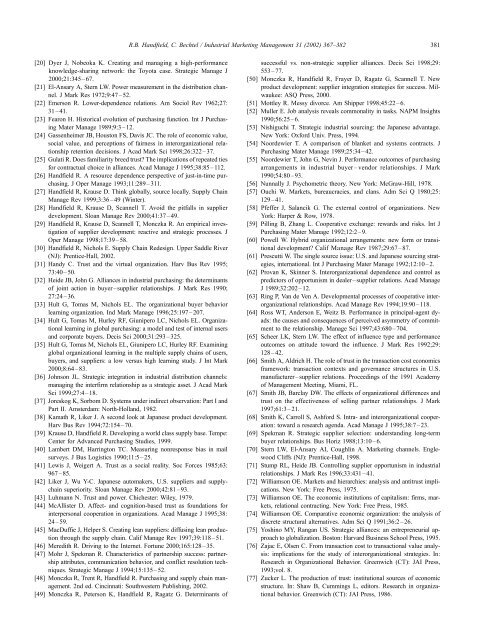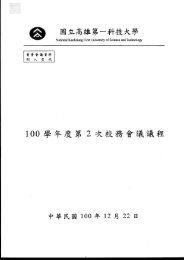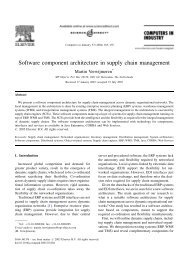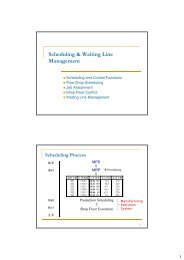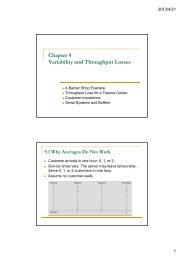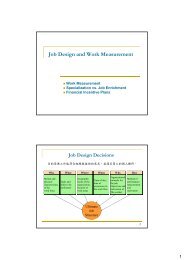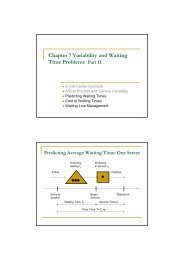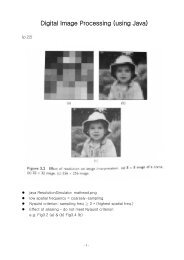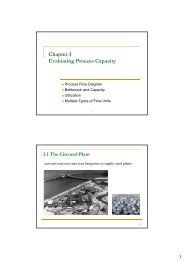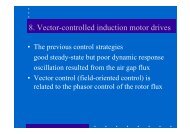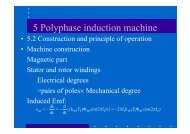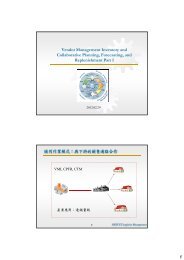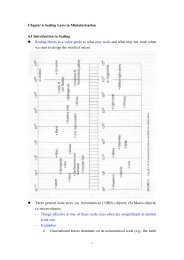The role of trust and relationship structure in improving supply chain ...
The role of trust and relationship structure in improving supply chain ...
The role of trust and relationship structure in improving supply chain ...
Create successful ePaper yourself
Turn your PDF publications into a flip-book with our unique Google optimized e-Paper software.
R.B. H<strong>and</strong>field, C. Bechtel / Industrial Market<strong>in</strong>g Management 31 (2002) 367–382 381[20] Dyer J, Nobeoka K. Creat<strong>in</strong>g <strong>and</strong> manag<strong>in</strong>g a high-performanceknowledge-shar<strong>in</strong>g network: the Toyota case. Strategic Manage J2000;21:345– 67.[21] El-Ansary A, Stern LW. Power measurement <strong>in</strong> the distribution channel.J Mark Res 1972;9:47–52.[22] Emerson R. Lower-dependence relations. Am Sociol Rev 1962;27:31–41.[23] Fearon H. Historical evolution <strong>of</strong> purchas<strong>in</strong>g function. Int J Purchas<strong>in</strong>gMater Manage 1989;9:3–12.[24] Gassenheimer JB, Houston FS, Davis JC. <strong>The</strong> <strong>role</strong> <strong>of</strong> economic value,social value, <strong>and</strong> perceptions <strong>of</strong> fairness <strong>in</strong> <strong>in</strong>terorganizational <strong>relationship</strong>retention decisions. J Acad Mark Sci 1998;26:322–37.[25] Gulati R. Does familiarity breed <strong>trust</strong>? <strong>The</strong> implications <strong>of</strong> repeated tiesfor contractual choice <strong>in</strong> alliances. Acad Manage J 1995;38:85 – 112.[26] H<strong>and</strong>field R. A resource dependence perspective <strong>of</strong> just-<strong>in</strong>-time purchas<strong>in</strong>g.J Oper Manage 1993;11:289–311.[27] H<strong>and</strong>field R, Krause D. Th<strong>in</strong>k globally, source locally. Supply Cha<strong>in</strong>Manage Rev 1999;3:36– 49 (W<strong>in</strong>ter).[28] H<strong>and</strong>field R, Krause D, Scannell T. Avoid the pitfalls <strong>in</strong> supplierdevelopment. Sloan Manage Rev 2000;41:37 –49.[29] H<strong>and</strong>field R, Krause D, Scannell T, Monczka R. An empirical <strong>in</strong>vestigation<strong>of</strong> supplier development: reactive <strong>and</strong> strategic processes. JOper Manage 1998;17:39–58.[30] H<strong>and</strong>field R, Nichols E. Supply Cha<strong>in</strong> Redesign. Upper Saddle River(NJ): Prentice-Hall, 2002.[31] H<strong>and</strong>y C. Trust <strong>and</strong> the virtual organization. Harv Bus Rev 1995;73:40–50.[32] Heide JB, John G. Alliances <strong>in</strong> <strong>in</strong>dustrial purchas<strong>in</strong>g: the determ<strong>in</strong>ants<strong>of</strong> jo<strong>in</strong>t action <strong>in</strong> buyer–supplier <strong>relationship</strong>s. J Mark Res 1990;27:24–36.[33] Hult G, Tomas M, Nichols EL. <strong>The</strong> organizational buyer behaviorlearn<strong>in</strong>g organization. Ind Mark Manage 1996;25:197–207.[34] Hult G, Tomas M, Hurley RF, Giunipero LC, Nichols EL. Organizationallearn<strong>in</strong>g <strong>in</strong> global purchas<strong>in</strong>g: a model <strong>and</strong> test <strong>of</strong> <strong>in</strong>ternal users<strong>and</strong> corporate buyers. Decis Sci 2000;31:293–325.[35] Hult G, Tomas M, Nichols EL, Giunipero LC, Hurley RF. Exam<strong>in</strong><strong>in</strong>gglobal organizational learn<strong>in</strong>g <strong>in</strong> the multiple <strong>supply</strong> cha<strong>in</strong>s <strong>of</strong> users,buyers, <strong>and</strong> suppliers: a low versus high learn<strong>in</strong>g study. J Int Mark2000;8:64– 83.[36] Johnson JL. Strategic <strong>in</strong>tegration <strong>in</strong> <strong>in</strong>dustrial distribution channels:manag<strong>in</strong>g the <strong>in</strong>terfirm <strong>relationship</strong> as a strategic asset. J Acad MarkSci 1999;27:4–18.[37] Joreskog K, Sorbom D. Systems under <strong>in</strong>direct observation: Part I <strong>and</strong>Part II. Amsterdam: North-Holl<strong>and</strong>, 1982.[38] Kamath R, Liker J. A second look at Japanese product development.Harv Bus Rev 1994;72:154–70.[39] Krause D, H<strong>and</strong>field R. Develop<strong>in</strong>g a world class <strong>supply</strong> base. Tempe:Center for Advanced Purchas<strong>in</strong>g Studies, 1999.[40] Lambert DM, Harr<strong>in</strong>gton TC. Measur<strong>in</strong>g nonresponse bias <strong>in</strong> mailsurveys. J Bus Logistics 1990;11:5–25.[41] Lewis J, Weigert A. Trust as a social reality. Soc Forces 1985;63:967–85.[42] Liker J, Wu Y-C. Japanese automakers, U.S. suppliers <strong>and</strong> <strong>supply</strong>cha<strong>in</strong>superiority. Sloan Manage Rev 2000;42:81 –93.[43] Luhmann N. Trust <strong>and</strong> power. Chichester: Wiley, 1979.[44] McAllister D. Affect- <strong>and</strong> cognition-based <strong>trust</strong> as foundations for<strong>in</strong>terpersonal cooperation <strong>in</strong> organizations. Acad Manage J 1995;38:24–59.[45] MacDuffie J, Helper S. Creat<strong>in</strong>g lean suppliers: diffus<strong>in</strong>g lean productionthrough the <strong>supply</strong> cha<strong>in</strong>. Calif Manage Rev 1997;39:118–51.[46] Meredith R. Driv<strong>in</strong>g to the Internet. Fortune 2000;165:128–35.[47] Mohr J, Spekman R. Characteristics <strong>of</strong> partnership success: partnershipattributes, communication behavior, <strong>and</strong> conflict resolution techniques.Strategic Manage J 1994;15:135– 52.[48] Monczka R, Trent R, H<strong>and</strong>field R. Purchas<strong>in</strong>g <strong>and</strong> <strong>supply</strong> cha<strong>in</strong> management.2nd ed. C<strong>in</strong>c<strong>in</strong>nati: Southwestern Publish<strong>in</strong>g, 2002.[49] Monczka R, Peterson K, H<strong>and</strong>field R, Ragatz G. Determ<strong>in</strong>ants <strong>of</strong>successful vs. non-strategic supplier alliances. Decis Sci 1998;29:553–77.[50] Monczka R, H<strong>and</strong>field R, Frayer D, Ragatz G, Scannell T. Newproduct development: supplier <strong>in</strong>tegration strategies for success. Milwaukee:ASQ Press, 2000.[51] Mottley R. Messy divorce. Am Shipper 1998;45:22– 6.[52] Muller E. Job analysis reveals commonality <strong>in</strong> tasks. NAPM Insights1990;56:25– 6.[53] Nishiguchi T. Strategic <strong>in</strong>dustrial sourc<strong>in</strong>g: the Japanese advantage.New York: Oxford Univ. Press, 1994.[54] Noordewier T. A comparison <strong>of</strong> blanket <strong>and</strong> systems contracts. JPurchas<strong>in</strong>g Mater Manage 1989;25:34 –42.[55] Noordewier T, John G, Nev<strong>in</strong> J. Performance outcomes <strong>of</strong> purchas<strong>in</strong>garrangements <strong>in</strong> <strong>in</strong>dustrial buyer –vendor <strong>relationship</strong>s. J Mark1990;54:80– 93.[56] Nunnally J. Psychometric theory. New York: McGraw-Hill, 1978.[57] Ouchi W. Markets, bureaucracies, <strong>and</strong> clans. Adm Sci Q 1980;25:129–41.[58] Pfeffer J, Salancik G. <strong>The</strong> external control <strong>of</strong> organizations. NewYork: Harper & Row, 1978.[59] Pill<strong>in</strong>g B, Zhang L. Cooperative exchange: rewards <strong>and</strong> risks. Int JPurchas<strong>in</strong>g Mater Manage 1992;12:2– 9.[60] Powell W. Hybrid organizational arrangements: new form or transitionaldevelopment? Calif Manage Rev 1987;29:67–87.[61] Prescutti W. <strong>The</strong> s<strong>in</strong>gle source issue: U.S. <strong>and</strong> Japanese sourc<strong>in</strong>g strategies,<strong>in</strong>ternational. Int J Purchas<strong>in</strong>g Mater Manage 1992;12:10– 2.[62] Provan K, Sk<strong>in</strong>ner S. Interorganizational dependence <strong>and</strong> control aspredictors <strong>of</strong> opportunism <strong>in</strong> dealer–supplier relations. Acad ManageJ 1989;32:202– 12.[63] R<strong>in</strong>g P, Van de Ven A. Developmental processes <strong>of</strong> cooperative <strong>in</strong>terorganizational<strong>relationship</strong>s. Acad Manage Rev 1994;19:90 – 118.[64] Ross WT, Anderson E, Weitz B. Performance <strong>in</strong> pr<strong>in</strong>cipal-agent dyads:the causes <strong>and</strong> consequences <strong>of</strong> perceived asymmetry <strong>of</strong> commitmentto the <strong>relationship</strong>. Manage Sci 1997;43:680–704.[65] Scheer LK, Stern LW. <strong>The</strong> effect <strong>of</strong> <strong>in</strong>fluence type <strong>and</strong> performanceoutcomes on attitude toward the <strong>in</strong>fluence. J Mark Res 1992;29:128–42.[66] Smith A, Aldrich H. <strong>The</strong> <strong>role</strong> <strong>of</strong> <strong>trust</strong> <strong>in</strong> the transaction cost economicsframework: transaction contexts <strong>and</strong> governance <strong>structure</strong>s <strong>in</strong> U.S.manufacturer – supplier relations. Proceed<strong>in</strong>gs <strong>of</strong> the 1991 Academy<strong>of</strong> Management Meet<strong>in</strong>g, Miami, FL.[67] Smith JB, Barclay DW. <strong>The</strong> effects <strong>of</strong> organizational differences <strong>and</strong><strong>trust</strong> on the effectiveness <strong>of</strong> sell<strong>in</strong>g partner <strong>relationship</strong>s. J Mark1997;61:3– 21.[68] Smith K, Carroll S, Ashford S. Intra- <strong>and</strong> <strong>in</strong>terorganizational cooperation:toward a research agenda. Acad Manage J 1995;38:7–23.[69] Spekman R. Strategic supplier selection: underst<strong>and</strong><strong>in</strong>g long-termbuyer <strong>relationship</strong>s. Bus Horiz 1988;13:10 – 6.[70] Stern LW, El-Ansary AI, Coughl<strong>in</strong> A. Market<strong>in</strong>g channels. EnglewoodCliffs (NJ): Prentice-Hall, 1998.[71] Stump RL, Heide JB. Controll<strong>in</strong>g supplier opportunism <strong>in</strong> <strong>in</strong>dustrial<strong>relationship</strong>s. J Mark Res 1996;33:431–41.[72] Williamson OE. Markets <strong>and</strong> hierarchies: analysis <strong>and</strong> anti<strong>trust</strong> implications.New York: Free Press, 1975.[73] Williamson OE. <strong>The</strong> economic <strong>in</strong>stitutions <strong>of</strong> capitalism: firms, markets,relational contract<strong>in</strong>g. New York: Free Press, 1985.[74] Williamson OE. Comparative economic organization: the analysis <strong>of</strong>discrete structural alternatives. Adm Sci Q 1991;36:2– 26.[75] Yosh<strong>in</strong>o MY, Rangan US. Strategic alliances: an entrepreneurial approachto globalization. Boston: Harvard Bus<strong>in</strong>ess School Press, 1995.[76] Zajac E, Olsen C. From transaction cost to transactional value analysis:implications for the study <strong>of</strong> <strong>in</strong>terorganizational strategies. In:Research <strong>in</strong> Organizational Behavior. Greenwich (CT): JAI Press,1993;vol. 8.[77] Zucker L. <strong>The</strong> production <strong>of</strong> <strong>trust</strong>: <strong>in</strong>stitutional sources <strong>of</strong> economic<strong>structure</strong>. In: Shaw B, Cumm<strong>in</strong>gs L, editors. Research <strong>in</strong> organizationalbehavior. Greenwich (CT): JAI Press, 1986.


